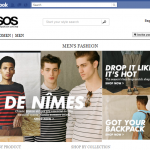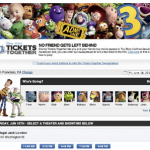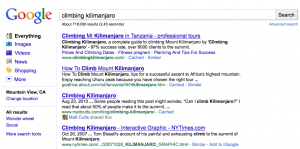Google +1 and the rise of social search
March 31, 2011
Yesterday, Google announced the launch of their ‘+1’ button. ‘+1’ is a continuation of Google’s desire to make social features more central to a user’s search experience and also challenge Facebook’s ‘Like’ platform . The button will allow anyone with a Google Profile to ‘+1’ their favourite sites and provides the ‘social search’ that Google has long been talking about.
What does the ‘+1’ button offer? Like the Facebook ‘Like’ button, users will have the ability to ‘+1′ different Google items. All they have to do is log in to their Google Profile, click ‘+1’ on a webpage or ad you find useful and it will then start appearing in Google’s search results by friends, contacts and others on the web. (If you can’t yet see the +1 button in your search results you can enable it in Google experimental.)
These social results promise to be more relevant to the user searching through thousands or millions of results. Google claim that “The beauty of +1s is their relevance—you get the right recommendations (because they come from people who matter to you), at the right time (when you are actually looking for information about that topic) and in the right format (your search results).”
The +1 button goes beyond showing up in search results – and this is where it will prove even more useful to brands’ online visibility. Google will attempt to rival Facebook’s ‘Like’ button by offering publishers a +1 button that lets users +1 something without leaving the business’ site. The appeal of utilising this is that the search giant has stated that +1 data will directly influence its market share dominating search rankings.
Where is social search heading?
It has been claimed that with the changes that Google are implementing search engine optimisation as we know it will be transformed. +1 is a clear indication that Google view the integration of social and search as the future – and that their search results will become more and more weighted by social interaction.
‘+1s’, Likes, comments and Tweets are going to become increasingly important when it comes to site optimisation and ensuring your business ranks highly. It is therefore crucial that brands engage across social platforms. Businesses must drive engagement and encourage people to share content in order to optimise their site and generate organic traffic.
By increasing social media functionality and interaction in what they offer Google is changing the face of search and how the user will experience it. For businesses this means they must engage with people on social spaces and get people to ‘+1’ their content in order to optimise their presence on Google.
Social ecommerce: how social media is transforming ecommerce
March 28, 2011
Social ecommerce is a term you will be hearing a lot. It is at the forefront of marketers’ discussions and looks set to redefine ecommerce. In August 2010 Mark Zuckerberg stated that “If I had to guess, social commerce is the next area to blow up”. Since then social ecommerce (or Facebook commerce or F-commerce, if you prefer) has moved on apace. You can now rent films, book plane tickets, make donations to charities purchase clothes and even buy Tomato Sauce – all through branded Facebook Store tabs.
The rise of Facebook ecommerce has transformed Facebook Pages, allowing brands to not only engage with fans but also sell to them. Businesses are starting to realise the value of using Facebook not just to engage but to translate the conversations they are having with fans on Facebook into conversions.
Facebook now provides a tangible difference to a business’ bottom line. This is obviously a very enticing opportunity for marketers. There are more than 30 million people on Facebook in the UK alone (out of a global potential of 600 million). Social ecommerce means that brands can provide a one-stop-shop where consumers can get everything they need without ever leaving Facebook. This is a huge opportunity to convert Fans into customers.
However, how do you leverage your Facebook store to maximise profits and brand engagement?
- Holistic social ecommerce solution
Brands need to understand that social media is about trust and relevance. There are a number of key elements that must feature in any social media community – and your social ecommerce programme must utilise these. This includes ease of use, brand trust and personalised offers, coupled with high levels of customer support and advice. Creating such a holistic solution ensures your social ecommerce activity fits seamlessly into your social media offering.
Retailers must focus on keeping brand advocate experiences social and engaging – adding value to your customers’ brand experience at every stage of the buying process – instead of solely focusing on sales. It is through providing this complete brand experience that you will maximise sales.
- Social ecommerce and sharing
Social media has reinvigorated word of mouth marketing – and likewise social ecommerce encourages a personalised shopping experience, based on sharing and the trusted opinions of peers.
The very nature of social media means that brands are dealing with consumers to whom discussing and sharing things with their friends is second nature. Brands must therefore use Facebook share, ‘Like’ and review APIs to maximise the visibility of their brand, their products and their Facebook store tab.
Brands need to provide shareable, relevant content. Get this right and you have an audience who are willing to recommend you to their peer group. Facebook store apps make this easy – they include many social features which means shoppers can easily share products they Like with their Facebook friends as well. This produces a social domino effect, with your brand featured on more and more users’ news feeds – and it will optimise your online visibility and sales.
- Facebook ‘Like’ to Facebook ‘Buy’
For marketers and brands alike social ecommerce offers so many possibilities because it provides a concrete link between ‘Likes’ and a business’ bottom line.
Facebook has developed a range of tools that allows brands to track this. Facebook Insights allows you to track the performance of your e-commerce platform – this includes metrics for specific features such as ‘Likes’ and shares as well as demographic information and user behaviour. The information can then be used to understand what messages, deals and rewards will be most effective in gaining customers and maximising sales.
This ability to understand your audience and tailor how and when you communicate with them is what makes social ecommerce such a compelling solution for brands.
The future for social commerce
Facebook’s ecommerce solution has created a huge potential marketplace – and explains why it such a hot topic. However, it is also here to stay. Facebook audiences are receptive to brand messages, willing to share information and buy products from brands. A Facebook ecommerce tab is a cost effective, tangible and unique way for brands to provide a complete user experience in a social space.
It’s crucial for brands to understand exactly how they can convert ‘Likes’ into buys and, most importantly, how they can make their ecommerce platform a fully integrated part of their wider social media strategy. It is only through this process that brands will not only maximise sales but also encourage brand loyalty.
Branding and social media: living the brand
March 9, 2011
For brands one of the central goals of social media is to create communities who are passionate and interested in what you are saying – and as social media continues to play an increasingly important role in people’s lives it means that the opportunities for brands to do this are growing.
Brands need to take advantage of this. That means not just creating short-term campaigns, but long-term programmes that build the brand and foster a loyal audience. Brands can no longer simply push out a campaign message – they must deliver a brand experience. It is, in short, all about living the brand.
This is because social media offers unique ways of conveying a brand’s personality in a more tangible way than traditional media ever has.
Social media has allowed businesses to focus on understanding their audience further, how they can actualise the brand and provide a unique relationship that benefits advocates.
This is not a simple task. It’s a long-term process and brands need to create conversations and content that engage, entertain and keep the audience coming back. However, the rewards are vast. It means brands and businesses have the ability to impact on all areas of the buying cycle – from the initial consideration of the brand and the moment of purchase right through to creating loyal customers who come back again and again.
Here are 3 crucial ways businesses can achieve this:
Interact with your target audience
Brands must engage. It sounds simple but it’s crucial. Your consumers need to know that if they comment on your brand’s Facebook or Twitter Page, or any other community spaces your brand have a presence on, that they will get a reply within an hour.
They also need to know that your brand is authentic and transparent in what you are offering. This real time customer service means they are talking directly to the brand – and it is this personal touch that provides your brand with authenticity and trustworthiness.
Brands must also encourage user generated content and get people to share this content. The goal? Get as many relevant people as possible engaged with your brand. Word of Mouth marketing in this way is extremely powerful. The ripple effect of users receiving and viewing information about your brand from their friends and followers not only puts your brand name in front of millions of online users but makes users more receptive to your message.
Create valuable relationships
Social media offers the perfect tools to engage with customers, ‘live the brand’ and have meaningful interactions that add value. From conversations with their target audience to the promotion of special offers and events, there are a number of ways in which businesses can actualise their brand. By utilising the right platforms at the right time brands can create an emotional connection with their target audience and ensure they are front of mind.
Actualise the brand
Actualising the brand proposition online is all about ‘Why?’. A customer’s attention is hard to maintain. With so many channels and businesses vying for attention, if brands are not relevant and interesting they will not be listened to. Social media incentivise people to become advocates – brands need to communicate their USPs, provide engaging content and offer a unique community experience. This is living the brand and means you can create brand ambassadors and ensure customer loyalty.
The growth of social search
March 2, 2011
The rise in importance of social media was demonstrated this month with the announcement that Google were giving increasing prominence to results from social networks.
On February 17th Google launched major updates to Social Search, integrating information from Twitter, Flickr and Quora throughout its search engine – with Facebook conspicuous by its absence. This is undoubtedly because of partnership agreed between Microsoft and Facebook that brings “Like” data and profile search to Bing. This means Google doesn’t receive Facebook data that happens on personal Facebook walls in the way that Bing has been getting from Facebook. Google still doesn’t even have access to Facebook Like data because it objects to some of Facebook’s terms and conditions for having access to this information.
Indeed, it is almost certainly because of this rivalry and the competition posed by Facebook that Google has launched so many updates over the last few years in an effort to unite social and search. These reasons also mean that there will be a lot more updates from Google in the future to keep pace with the growing popularity of social media.
In summary: what the new changes mean
The new changes provide the ability to see results based on what the people you follow, and are connected to, are viewing and sharing. This means that if you are logged into your Google Account you may begin to see listings shared by your connections within organic search results.
Here are the most important aspects of these changes and how they will change your Google experience:
- Possibly the most important result of Google’s changes is that there will be a huge increase in social media’s appearance in search – now any content shared by your friends on Twitter, Flickr and new Q&A site Quora may now appear in your search results.
- The outcome of this is that different people will see different results. That’s because results will now be based on your individual relationship with the people who have shared content. The stronger your connection, the higher it will be found in the organic listings.
- By allowing users to connect their social profiles to their Google accounts the search giant can judge the strength of your connections by cross referencing your friends on Google’s network of sites and seeing if that list matches your friend list on other social networks such as Twitter. This will in turn influence your search results.
So, social search results will now be found with all other results, not just along the bottom of the page. However, it will be easy to spot which results are taken from social networks – they will be indicated by a sentence underneath the URL which will tell you which of your connections shared the link. As you can see below (click on the image to make it larger):
Much has been made of the battle between social and search but it seems that they are becoming more and more closely integrated. The question is: will Google and Facebook ever be able to resolve their differences?





